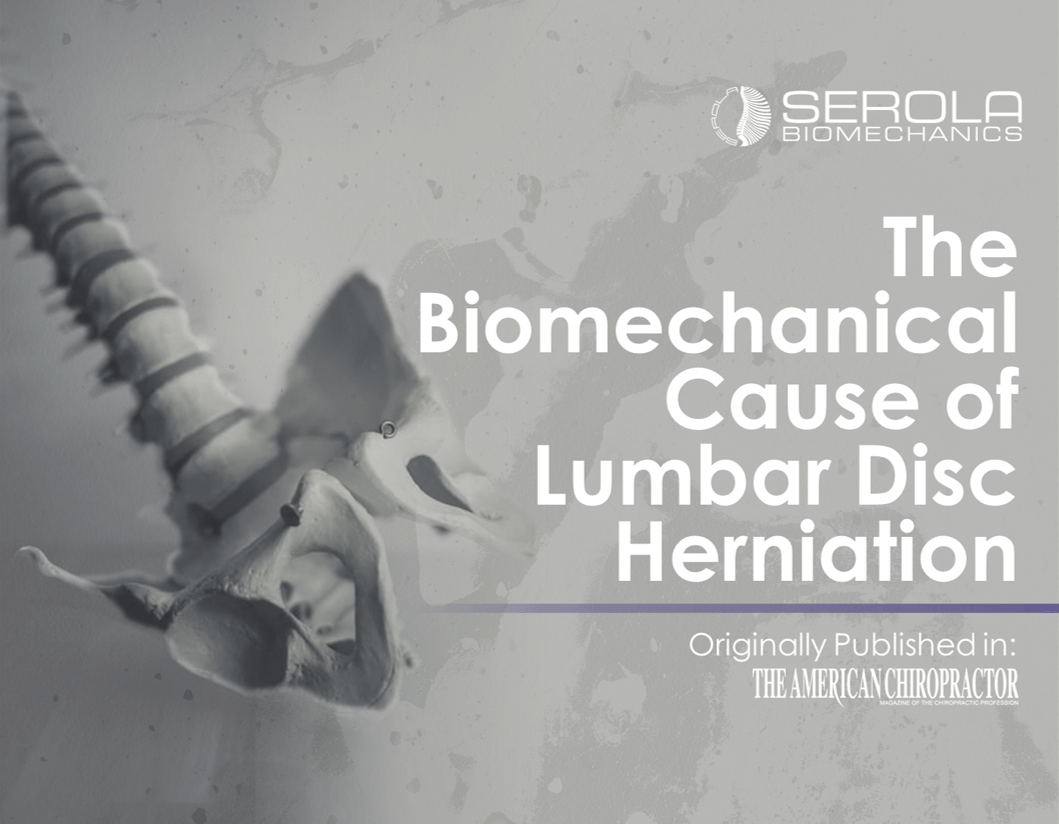
During normal anatomical standing, with balanced weight bearing, the spine should not be laterally flexed or rotated. The sacral apex should be neutral, evenly spaced between the right and left ischia. The height of the ilia should be even, with no rotation. If I am correct, this pattern may not exist on any back-pain patients.
CLARIFYING SIJ MOVEMENT
Balanced Movement
In normal movement of the spine, most vertebrae move in unison, in the same direction as the ones immediately above and below. But, in normal movement of the pelvis, there is a significant difference; the sacrum and ilium move in opposite directions. The body basically divides into an upper half with one end at the sacrum, and a lower half with one end at the ilium. The opposing actions of these two halves create balance in movement, force transfer, and musculoskeletal coordination. The SIJ ligaments regulate muscle activity to maintain normal range of motion and provide a stop point at the end of the physiological limit, where movement is reversed.
Cardinal Plane vs. Relative Movement
Because the pelvis undergoes large movement patterns in the cardinal planes, it appears that both the sacrum and ilium move in the same direction. Due to the larger size of the ilium, with many more muscles attached to it, in a gross movement perspective, the ilium carries the sacrum with it in the cardinal planes. But it is important to remember that, relative to each other, they move in opposite directions; this is a key factor in understanding the function of our core structure in the overall movement pattern of the musculoskeletal system. Remember that the cardinal planes are an interpretation of movement for positional reference, but reciprocal nutation/counternutation movements are the actual movements of the sacrum and ilium relative to each other. All physiological functions are based on relative movement.
Bilateral vs. Unilateral Movement
Before we go further, we should differentiate between bilateral and unilateral pelvic movement, a sticking point in understanding sacroiliac joint (SIJ) movement. Bilateral pelvic movement is when the entire sacral base moves in the same direction; as the sacral base moves forward, both ilia move backward[1, 2]. The simplicity of this pattern is easy to visualize, so it is used in most of the older literature, but is extremely rare in a pure sense, if it occurs at all. As our understanding of the SIJ has progressed, we have been seeing more of the true pattern of reciprocal, unilateral movement in the literature, as explained below.
Reciprocating Movement Pattern
For accurate interpretation, it is important to visualize the sacrum as having left and right sides. One side of the sacrum moves in an opposite pattern to the ipsilateral ilium and the ipsilateral ilium moves in an opposite pattern to the contralateral ilium[3, 4]. For example, during right nutation, as the right side of the sacrum moves anteriorly, inferiorly and rotates contralaterally, the right ilium moves posteriorly, superiorly, and rotates ipsilaterally. The contralateral side will be in the opposite pattern of counternutation. To visualize this reciprocal pattern, think of gait.
During weight bearing on left, as the left leg moves posteriorly, the left ilium also moves posteriorly, rotating the pelvis to the left, which results in a left PI ilium (nutation).
– The right ilium undergoes counternutation, moving anteriorly and superiorly (AS) while rotating to the left.
– The left side of the sacrum moves relatively anteriorly and inferiorly, rotating the spine to the right.
– The sacral apex moves to the right, forming the base of a lateral spinal C-curve flexed to the right.
– The left lumbar and cervical lordosis increase, and the left thoracic kyphosis decreases.
Due to the ties between L4 and L5 to the ilium by the iliolumbar ligaments, these two lumbar vertebrae rotate to the left with the ilium, while the rest of the lumbar spine rotates with the sacrum to the right, setting up a counterrotation at L3-4 and L5-S1; the involved lumbar discs are made for this due to the cross-hatching of the annular fibers. Normal rotation is about 3 degrees.
These actions quickly reverse as we step onto the right foot.
INJURY
Because load transfer through the pelvis occurs during nutation, it is the position where most SIJ injuries occur. If the rest of the spine above the sacrum fell into nutation, we would lose balance and any further nutating force would induce collapse on that side.
Instead, the body counterbalances itself by limiting nutation on the injured side. For example, in a right nutation injury, the nutation limiting ligaments lose some ability to resist loading forces. In accordance with the reciprocating nature of the SIJ, the body would act to induce nutation on the left side and counternutation on the injured right side. This response would last as long as the ligaments are compromised.
Compensation Pattern
During normal movement, the entire body will reciprocate left-right-left, etc. During gait, we should see the hips and spine rotate in opposite directions. The sacral apex moves to the non-weight bearing side as the spine laterally flexes and rotates to the non-weight bearing side.
But, after SIJ injury, the ligaments will direct the muscles to reduce their reciprocating pattern to avoid stressing the damaged ligaments[5, 6], which means avoiding right nutation, commensurate with the degree of injury. Losing or significantly reducing the reciprocating movement of the body, the spine will remain in some degree of counternutation on the right, including an AS pelvis with a posterior superior sacral base. The sacral apex will remain on the right to some degree as the thoracolumbar curve above L3 will remain rotated and flexed to the right.
Further, the righting reflex will cause the upper thorax to counterrotate and flex to the left. Consequently, a rib hump will develop on the side opposite the major SIJ nutation injury; which can be a good diagnostic aid. Both sides may have a nutation injury, inducing varying degrees of compensation, but one side will always be the major.
Considering the cardinal planes, as the right ilium moves anteriorly, the right sacral base moves anteriorly with it. But physiologically, the posterior spinal muscles, inducing counternutation, attempt to pull the right sacral base posteriorly and superiorly by straightening the lumbar spine.
As a result, an acutely increased lordosis develops at L3-S1, with straightening of the spine above L3. In the lower lumbars the muscular pull creates an imbalance in which greater pressure is placed on the posterior motor units.
DISC HERNIATION
The counter-rotation at L3-4 and L5-S1, combined with posterior disc compression, will cause significant stress on the posterior annular fibers of the discs, as they grind with every breath and every step. Over the course of years, the posterior annular fibers will break down and weaken.
In erect posture, there is little danger of the nucleus herniating posteriorly because the posterior aspect of the vertebral unit is narrowed by the vertebrae themselves. The anterior fibers will not be markedly damaged, so they will contain the nucleus anteriorly. However, once the person bends forward, the lumbar spine flexes, the posterior aspect opens, and when the degenerated posterior annular fibers are insufficient, the nucleus herniates. Lifting a heavy weight will magnify the chance of herniation but, if the annular fibers are weak enough, it can happen when the person simply bends forward.
Preventive treatment options include:
– 1. Stabilizing the sacroiliac joint nutation lesion (Category II)
– 2. Decompressing the lumbosacral area by gently flexing the lumbosacral hyperlordosis, and maintaining mobility, before the annulus is significantly damaged.
References:
1. Kapandji, I.A., The Physiology of the Joints. Vol. 3. 1977: Churchill Livingstone.
2. Neumann, D., Kinesiology of the Musculoskeletal System. Foundations for Physical Medicine. 2002: Mosby.
3. Mitchell, F.L., Jr. and P.K.G. Mitchell, The Muscle Energy Manual. Vol. 3. 1999, East Lansing: MET Press.
4. DonTigny, R.L., Critical Analysis of the Functional Dynamics of the Sacroiliac Joints as They Pertain to Normal Gait. JOM, 2005. 27(1): p. 3-10.
5. Palmer, I., Pathophysiology of the medial ligament of the knee joint. Acta Chirurgica Scandinavica, 1958. 115(4): p. 312-8.
6. Solomonow, M., et al., The ligamento-muscular stabilizing system of the spine. Spine, 1998. 23(23): p. 2552-62.

